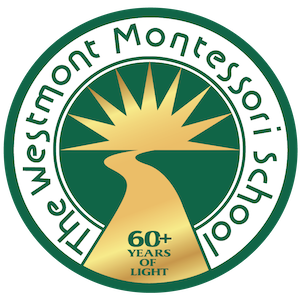By: Melanie Thiesse
This week Westmont presented a workshop for parents called, “The Marvels of Montessori Math” in which I outlined the progression of our math curriculum. For those of you who could not attend, I thought I would outline the presentation, sharing the highlights of the math that takes place everyday in every classroom at Westmont.
Math work begins (and continues) with the use of our Sensorial materials. These materials, many of them in sets of 10 (the base of our numbering system) and in heights, widths, and weights increasing in perfect mathematical symmetry, help the child to build discriminatory abilities. When you think about both math and reading, a keen awareness of subtle difference if very important if you are going to be able to tell the difference between an S and a 5.
Preschool children are often taught to count, but the important skill for math preparation is being able to understand that a numeric symbol represents a given quantity. We have numerous materials in our classes for children to practice counting and sorting numbers and matching them to their numeral.
Once children have a solid understanding of the numbers and quantities 0-9, they have concrete manipulatives to learn numbers in the teens. This concept, requiring the understanding of ten and unit place value, is easily taught using materials that are already familiar with the children.
Learning numbers 10-99 is also done with manipulatives, allowing the children to “fetch” different quantities with beads and building their numeral to match.
One of the more difficult tasks when learning to count larger numbers is the decade transitions, counting to 100 and remembering which number comes after 59 is a challenging task for a preschooler or kindergarten student. Our materials for that process include the 100 board where children can not only lay out numbered tiles in order from 1-100, but they can learn about patterns in numbers by laying out only the 10’s, the 5’s or even the 3’s. Discovering the patterns these numbers create of the 100 board can be an exciting task!

Getting the first lesson on the Bead Chains is a rite of passage in the Early Childhood classes! The bead chains are linked together bars of the squares or cubes of a given number. For example, the “Short 5 Chain” contains 5 bead bars of 5 beads each, for a total of 25 beads. The children will use this chain to count and at the end of each bar of 5, they will find and place the preprinted ticket with that numeral on it – When finished, finding 5, 10, 15, 20, 25. The amazing this about this activity is the ability for the child to begin counting again at the number where he last left off. So if he last counted 15, then searched for the corresponding ticket, found it, and placed it at the 15th bead, then he would then need to start counting at 16 up to 20. This is a difficult concept to master and one that will serve the child well when adding numbers together. Not to mention that it’s a great introduction to skip counting!

One of the all-time-favorites in our Early Childhood classes is the Golden Bead Material used to create the Decimal Layout. With these manipulatives, a child can create the quantity and numeral for any number from 1-9999!












